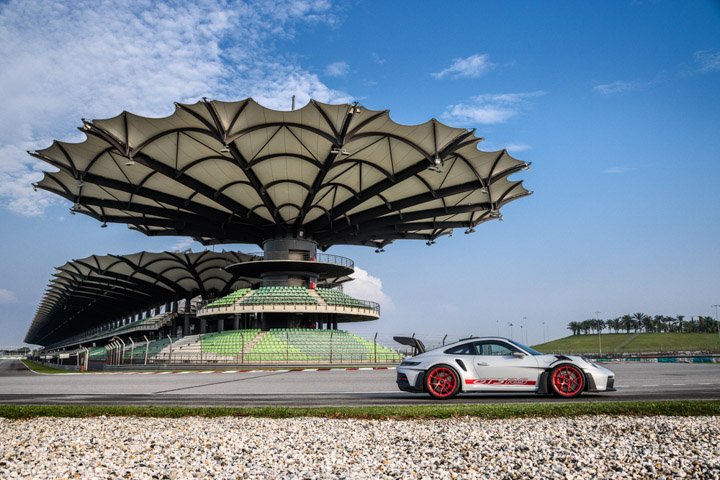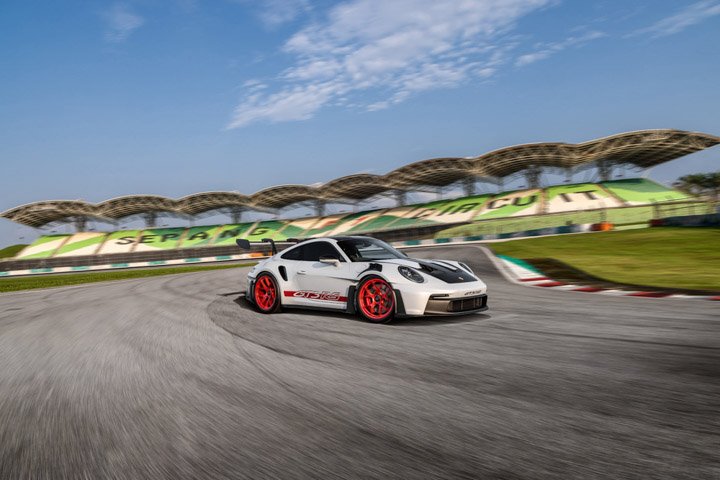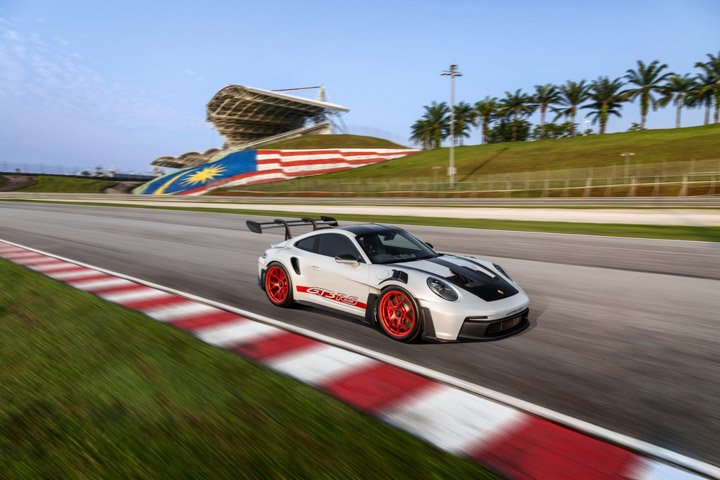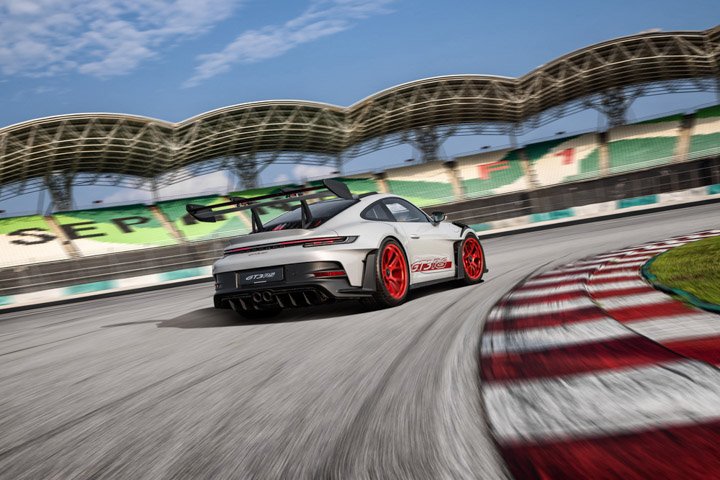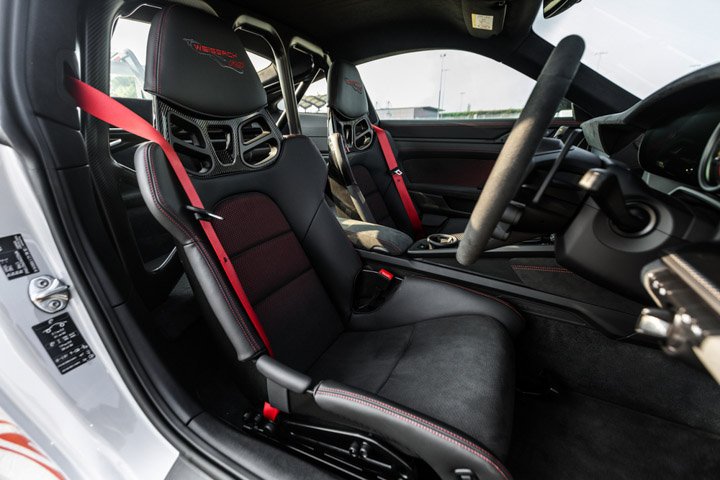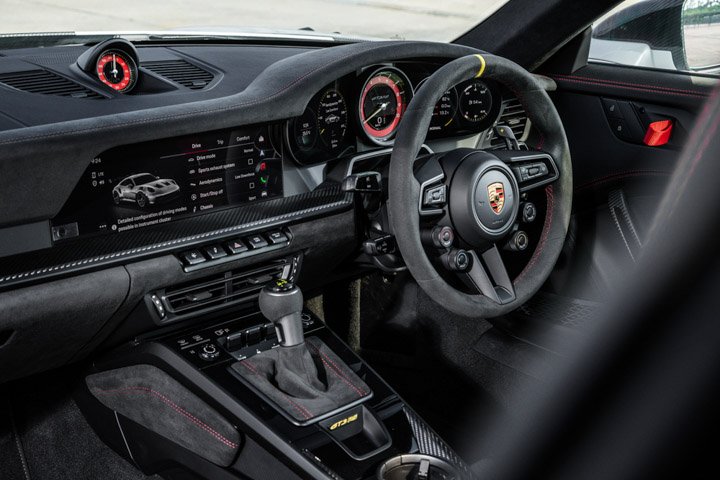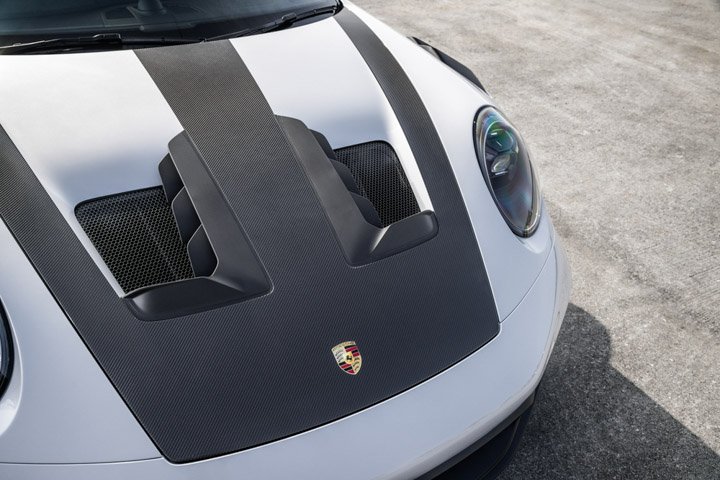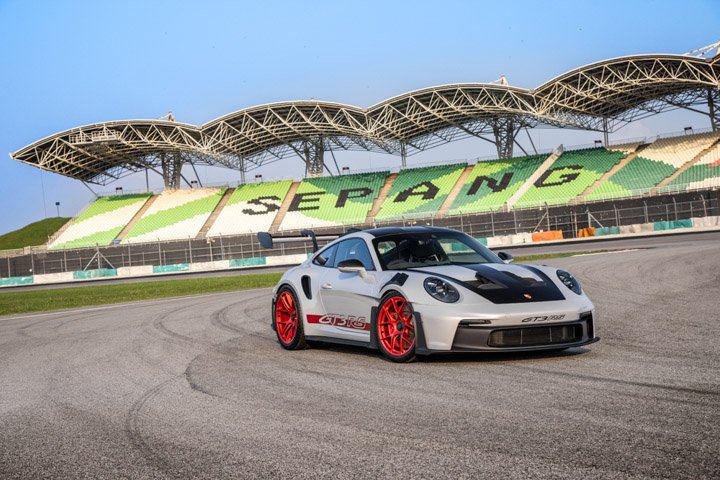
Porsche 911 GT3 RS launched at the start of Porsche Carrera Cup Asia at Sepang
The Porsche 911 GT3 RS is now available in Malaysia. The motorsports-inspired 992-generation Porsche 911 GT3 RS starts from RM 2,630,000 inclusive of duties and four-year warranty, before customisable options.
The road-legal high-performance sports car has a 4.0-litre naturally-aspirated engine which produces 517bhp (386 kW). The high-revving flat-six engine goes up to 9000rpm. The transmission is a seven-speed Porsche Doppelkupplung (PDK) gearbox. Acceleration from zero to 100 km/h is in 3.2 seconds, top speed is 296 km/h in seventh gear.
The front axle has aluminium monobloc fixed-calliper brakes with six pistons each and brake discs with a diameter of 408 mm. The piston diameters are now 32mm, increased from 30mm in the 911 GT3. In addition, the discs are now thicker at 36mm, from 34mm previously.
The rear axle has 380-mm brake discs and four-piston fixed-calliper brakes. The optionally available Porsche Ceramic Composite Brake (PCCB) has 410-mm discs on the front axle and 390-mm discs on the rear axle. The new 911 GT3 RS comes standard with forged light-alloy centre-lock wheels. Road-legal sports tyres measuring 275/35 R 20 at the front and 335/30 R21 at the rear ensure a high level of mechanical grip.
There are several features which improve aerodynamics in the GT3 RS. These include
- large, angled centre radiator
- a drag reduction system (DRS)
- swan-neck-supported rear wing
- front splitter
- sideblades
- louvred strakes above the front wings
- rear diffuser
- rear wheel with an intake and a sideblade
The radiator is now located in the centre, towards the nose. This frees up space to integrate continuously adjustable wing elements in the front and on the two-part rear wing. These provide 409 kg of total downforce at 200 km/h, twice as much downforce as its 991.2-generation predecessor and three times as much as a current 911 GT3. At 285 km/h, total downforce is 860 kg.
The Drag Reduction System (DRS) is the first in a production Porsche. The DRS enables low drag and higher speeds on straight sections of the track by flattening the wings, at the push of a button, within a specific operating range. The airbrake function is also activated during braking at high speeds: the wing elements at the front and rear are set to maximum, creating an aerodynamic deceleration effect that significantly supports the brakes.
The most prominent aerodynamic feature is the swan-neck-supported rear wing. The rear wing consists of a fixed main wing and an upper, hydraulically adjustable wing element. For the first time on a Porsche production vehicle, the upper edge of the rear wing is higher than the car’s roof. In addition, the front end of the 911 GT3 RS features a front splitter that divides the air flowing over and underneath, with sideblades accurately deflecting outwards for increased lateral stability.
Louvred strakes above the front wings, in the style of the iconic Le Mans-winning 911 GT1, reduce the turbulent pressure in the wheel arches. Hot air from the centrally positioned radiator flows out via large nostrils on the front lid, and fins on the roof direct the air outwards, ensuring cooler air enters the engine intakes at the rear. The openings in widened the rear arches are used exclusively to improve aerodynamics and not to draw in process air. The for optimised airflow. This is adapted from the 911 GT3.
Suspension adjustments on-the-fly
The components of the double-wishbone front axle have teardrop-shaped profiles. The shape increases downforce on the front axle by around 40kg at top speed. Because of the widened front track (29 millimetres wider than the 911 GT3), the double-wishbone front axle links on the new 911 GT3 RS are also correspondingly longer.
The 911 GT3 RS offers three driving modes: Normal, Sport and Track. In Track mode, there are more customisable settings. Four rotary dials are located on the steering wheel for this adjustment process, displayed dynamically via specific displays in the instrument cluster.
The 911 GT3 RS weighs in at only 1,450 kg (kerb weight according to DIN) despite many larger components. Lightweight construction measures include extensive use of CFRP on the doors, front wings, roof and front lid. The standard full bucket seats are also CFRP.
Available with Clubsport and Weissach packages
The interior is black leather, Racetex and carbon-weave finish. The Clubsport package is available at no extra cost. This consists of a steel rollover bar, a hand-held fire extinguisher and six-point seat belts for the driver.
The Weissach package is an option which features carbon-weave finish on the front lid, roof, parts of the rear wing and the upper shell of the exterior mirrors feature a carbon-weave finish. The front and rear anti-roll bars, the rear coupling rods and the shear panel on the rear axle are made of CFRP. These further enhance the driving dynamics. The rollover bar, constructed for the first time from CFRP, saves around six kilograms compared with the steel version.
Another highlight of the Weissach package is the PDK shift paddles with motorsport-derived magnet technology. This makes gear changes even more dynamic thanks to a more precise pressure point and a clearly perceptible click. Magnesium forged wheels are an additional option for the Weissach package. The wheels save another eight kilograms. For more information on the new 911 GT3 RS, kindly contact the nearest Porsche Centre to book your interest.
Exclusive Porsche Design Chronograph
Alongside the motorsports-inspired 911 is the 911 GT3 RS chronograph from Porsche’s own watchmaking operation in Solothurn, Switzerland. The mechanical watch is reserved for owners of the car. It is based on a glass-bead blasted case, made from either natural or black titanium, and with a screw-down crown.
Inside, is the mechanical Porsche Design chronograph calibre WERK 01.200. The accuracy is COSC-certified. The flyback function allows the wearer to start, stop and reset the second hand with a single action. The chronograph pushers, which feature ‘Start/Stop’ and ‘Next Lap’ laser engravings, reveal that this chronograph is not just about telling the time. There are innovations such as the pulsometer scale on the bezel as well as design features and materials from the GT3 RS.
Find out more about the new Porsche 911 GT3 RS at https://bit.ly/911GT3RS-launch.


